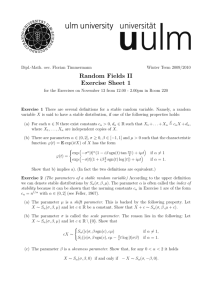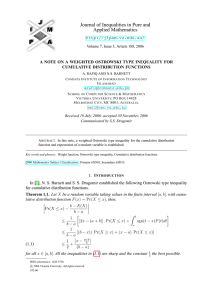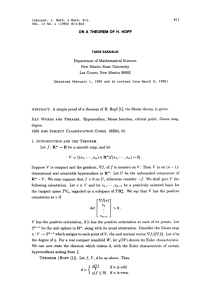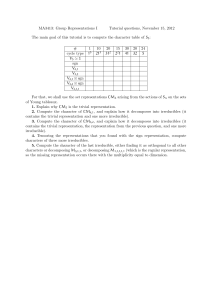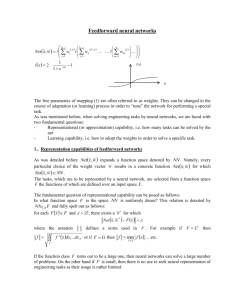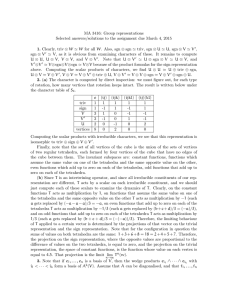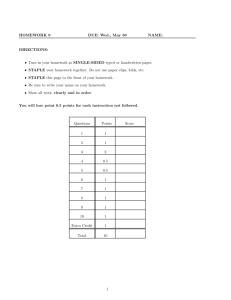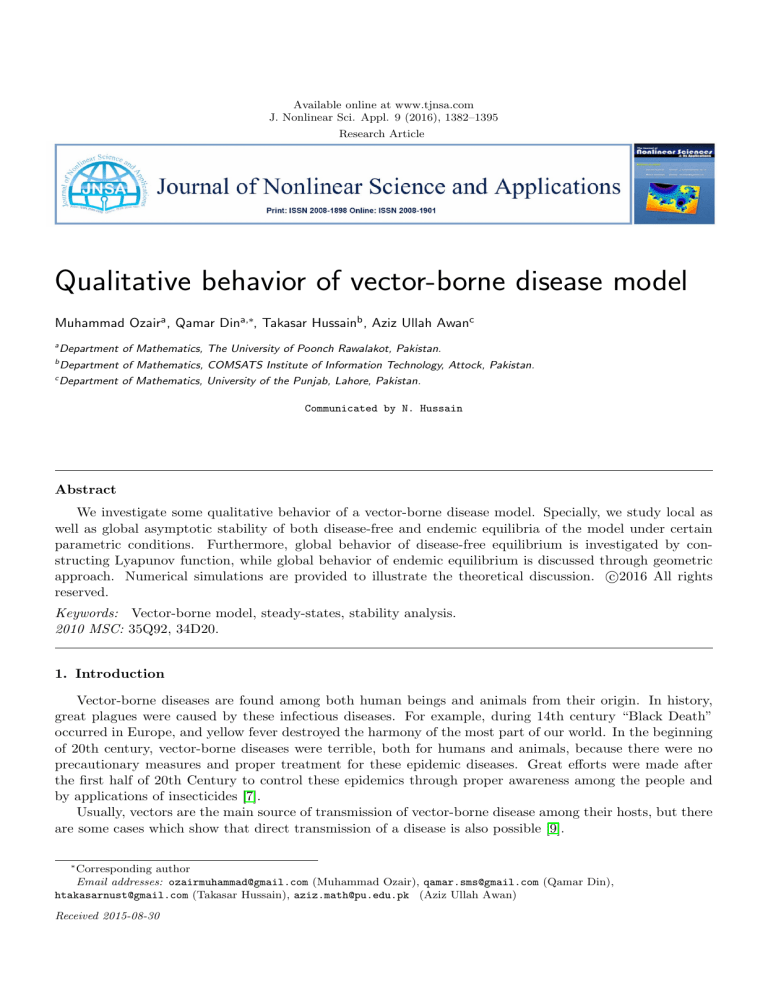
Available online at www.tjnsa.com
J. Nonlinear Sci. Appl. 9 (2016), 1382–1395
Research Article
Qualitative behavior of vector-borne disease model
Muhammad Ozaira , Qamar Dina,∗, Takasar Hussainb , Aziz Ullah Awanc
a
Department of Mathematics, The University of Poonch Rawalakot, Pakistan.
b
Department of Mathematics, COMSATS Institute of Information Technology, Attock, Pakistan.
c
Department of Mathematics, University of the Punjab, Lahore, Pakistan.
Communicated by N. Hussain
Abstract
We investigate some qualitative behavior of a vector-borne disease model. Specially, we study local as
well as global asymptotic stability of both disease-free and endemic equilibria of the model under certain
parametric conditions. Furthermore, global behavior of disease-free equilibrium is investigated by constructing Lyapunov function, while global behavior of endemic equilibrium is discussed through geometric
approach. Numerical simulations are provided to illustrate the theoretical discussion. c 2016 All rights
reserved.
Keywords: Vector-borne model, steady-states, stability analysis.
2010 MSC: 35Q92, 34D20.
1. Introduction
Vector-borne diseases are found among both human beings and animals from their origin. In history,
great plagues were caused by these infectious diseases. For example, during 14th century “Black Death”
occurred in Europe, and yellow fever destroyed the harmony of the most part of our world. In the beginning
of 20th century, vector-borne diseases were terrible, both for humans and animals, because there were no
precautionary measures and proper treatment for these epidemic diseases. Great efforts were made after
the first half of 20th Century to control these epidemics through proper awareness among the people and
by applications of insecticides [7].
Usually, vectors are the main source of transmission of vector-borne disease among their hosts, but there
are some cases which show that direct transmission of a disease is also possible [9].
∗
Corresponding author
Email addresses: ozairmuhammad@gmail.com (Muhammad Ozair), qamar.sms@gmail.com (Qamar Din),
htakasarnust@gmail.com (Takasar Hussain), aziz.math@pu.edu.pk (Aziz Ullah Awan)
Received 2015-08-30
M. Ozair, Q. Din, T. Hussain, A. U. Awan, J. Nonlinear Sci. Appl. 9 (2016), 1382–1395
1383
Many infectious diseases can be modeled through systems of nonlinear differential equations. Many
authors modeled these infectious diseases by introducing different incidence rates. Arguing as in [2, 3], it is
suitable to use standard incidence rates as compared to simple mass action incidence. It is more suitable
to construct a mathematical model with time-varying total population as compared to constant population,
because for most of the endemic diseases, such as malaria, or those diseases that have high mortality rates
(HIV/AIDS in poor countries), it is not appropriate to neglect the change in population size. Otherwise,
we can not obtain the desired results with high accuracy.
In [6], authors proved that the period of immunity for malaria depends on repeated exposure. Furthermore, Niger and Gumel [13] investigated the qualitative behavior of malaria model by considering the role of
partial immunity. A new mathematical model for malaria was proposed by Wan and Cui [17] by taking into
account the partially immune population. Nonlinear incidence with partial immunity was used by Ozair et
al. [14] in order to discuss dynamics of a vector-borne model. Recently, Ozair et al. [15] discussed a vectorhost disease model with standard incidence and variable human population. Motivated by the above study,
we want to modify the model presented in [11] and discuss its global behavior by constructing Laypunov
function and using compound matrices. The rest of the paper is organized as follows.
The second section is dedicated to mathematical description of the model. In the third section, we
discuss the existence and uniqueness of “endemic” equilibria. In the fourth section, we use Lyapunov
function theory to show global stability of “disease-free” equilibrium (DFE) and a geometric approach to
prove global stability of “endemic” equilibrium. Finally, discussions and simulations are presented in the
last section.
2. Model description and dimensionless formulation
The total host population Nh (t), described by SEIS model, is partitioned into three distinct compartments, susceptibles Sh (t), exposed or infected Eh (t) and infectious Ih (t). The vector population Nv (t) is
described by SEI model and it is also divided into three subclasses, namely susceptible Sv (t), exposed Ev (t)
and infectious Iv (t) classes. The proposed dynamical system is given by
dSh (t)
dt
dEh (t)
dt
dIh (t)
dt
dSv (t)
dt
dEv (t)
dt
dIv (t)
dt
Sh Ih
Sh Iv
− β2
− µh Sh + αh Ih ,
Nh
Nv
Sh Ih
Sh Iv
= β1
+ β2
− γh Eh − µh Eh ,
Nh
Nv
= b1 Nh − β1
= γh Eh − αh Ih − µh Ih − ξh Ih ,
Sv Ih
= dNv − β3
− dSv ,
Nh
Sv Ih
= β3
− γv Ev − dEv ,
Nh
(2.1)
= γv Ev − dIv .
In the above, b1 is the per-capita birth rate of humans that are assumed to be susceptible, µh is natural
mortality rate of humans and ξh is the disease induced death rate. Susceptible humans can be infected
through contact with an infected individual and the effective infection rate is represented by β1 . The
infectious individuals do not acquire permanent immunity and become susceptible again at the rate αh . If
the vector is infectious, then the average number of contacts per day that results in infection is β2 . Similarly
the effective contact rate between susceptible vectors and infectious humans is β3 . Newly infected individuals
develop clinical symptoms of the disease and move to the infectious class at the rate γh and exposed vectors
progress to the infectious class at the rate γv . We assume that the birth and death rates of the vector
population is equal to d so that it has constant size.
M. Ozair, Q. Din, T. Hussain, A. U. Awan, J. Nonlinear Sci. Appl. 9 (2016), 1382–1395
1384
Taking
Ev
Iv
Sh
Eh
Ih
Sv
, ev =
, iv =
,
, eh =
, ih =
, sv =
Nh
Nh
Nh
Nv
Nv
Nv
we arrive at the following normalized model
sh =
dsh (t)
dt
deh (t)
dt
dih (t)
dt
dsv (t)
dt
dev (t)
dt
div (t)
dt
(2.2)
= b1 (1 − sh ) − β1 sh ih − β2 sh iv + αh ih + ξh sh ih ,
= β1 sh ih + β2 sh iv − γh eh − b1 eh + ξh eh ih ,
= γh eh − αh ih − ξh ih − b1 ih + ξh ih 2 ,
(2.3)
= d(1 − sv ) − β3 sv ih ,
= β3 sv ih − γv ev − dev ,
= γv ev − div .
Since
sh + eh + ih = 1, sv + ev + iv = 1,
(2.4)
we can study the following subsystem
deh (t)
dt
dih (t)
dt
dev (t)
dt
div (t)
dt
= β1 (1 − eh − ih )ih + β2 (1 − eh − ih )iv − γh eh − b1 eh + ξh eh ih ,
= γh eh − αh ih − ξh ih − b1 ih + ξh ih 2 ,
(2.5)
= β3 (1 − ev − iv )ih − γv ev − dev ,
= γv ev − div .
This system is defined in the subset Γ × [0, ∞) of R5 + , where Γ = {eh , ih , ev , iv : 0 ≤ eh , ih , ev , iv ≤ 1, 0 ≤
eh + ih ≤ 1, 0 ≤ ev + iv ≤ 1} and the original quantities can be determined from the proportions through
(2.2) and (2.4). The Jacobian matrix at DFE E1 given by (eh , ih , ev , iv )=(0, 0, 0, 0) is
−(b1 + γh )
β1
0
β2
γh
−(b1 + αh + ξh )
0
0
.
J =
0
β
−(γ
+
d)
0
3
v
0
0
γv
−d
The characteristic equation for the above Jacobian matrix is given by
f (λ) = λ4 + a1 λ3 + a2 λ2 + a3 λ + a4 = 0,
where
a1 = (2d + γv ) + (2b1 + γh + αh + ξh ),
a2 = (b1 + γh )(b1 + αh + ξh ) − β1 γh + (2d + γv )(2b1 + γh + αh + ξh ) + d(γv + d),
a3 = (2d + γv )((b1 + γh )(b1 + αh + ξh ) − β1 γh ) + d(γv + d)(2b1 + γh + αh + ξh ),
a4 = d(γv + d)(b1 + γh )(b1 + αh + ξh )(1 − R0 ),
(2.6)
M. Ozair, Q. Din, T. Hussain, A. U. Awan, J. Nonlinear Sci. Appl. 9 (2016), 1382–1395
and
R0 =
1385
β2 β3 γh γv
β1 γh
+
,
Q1 Q3 dQ1 Q2 Q3
where Q1 = b1 + γh , Q2 = γv + d, Q3 = b1 + αh + ξh . The four eigenvalues of the above Jacobian matrix
have negative real parts if they satisfy the Routh–Hurwitz criteria [1], i.e., ai > 0 for i = 1, 2, 3, 4, with
a1 a2 a3 > a23 +a21 a4 . For R0 < 1, we have (b1 +γh )(b1 +αh +ξh )−β1 γh > 0 and so ai > 0 for i = 1, 2, 3, 4. It can
also be easily verified that a1 a2 a3 > a23 + a21 a4 . Thus, all the eigenvalues of the above characteristic equation
have negative real parts if and only if R0 < 1, which shows that the DFE E1 is locally asymptotically stable.
Remark 2.1. If R0 > 1, we have f (0) < 0 and f (λ) → +∞ as λ → +∞. Thus there exists at least one
λ∗ > 0 such that f (λ∗ ) = 0 which proves instability of DFE.
3. Endemic equilibrium
Let E2 = (e∗h , i∗h , e∗v , i∗v ) represents any arbitrary endemic equilibrium of the model (2.3). Solving system
(2.3) at steady state gives
(Q3 −ξh i∗h )i∗h
e∗h =
,
γh
β3 di∗v
∗
ev = Q2 (β3 i∗ +d) ,
(3.1)
h
β3 γv i∗h
Q2 (β3 i∗h +d) ,
i∗v =
where i∗h is a root of the following cubic equation
g(i∗h ) = m3 i∗h 3 + m2 i∗h 2 + m1 i∗h + m0 = 0,
(3.2)
with
m3 = Q2 β3 ξh (β1 − ξh ),
m2 = β1 Q2 dξh + β2 β3 γv ξh + b1 Q2 ξh β3 − (β1 − ξh )(γh Q2 β3 + Q2 Q3 β3 ),
m1 = (β3 Q2 γh − γh Q2 d − Q2 Q3 d)(β1 − ξh ) − b1 Q2 Q3 β3 − β2 β3 γv γh − β2 β3 γv Q3 + b1 Q2 ξh d,
(3.3)
m0 = dQ1 Q2 Q3 (R0 − 1).
Assuming R0 > 1, we have:
(1) If β1 > ξh , then m3 > 0, so we have g(−∞) < 0, g(∞) > 0 and g(0) = m0 > 0. Further, g(1) < 0 if
b1
∗
∗
2 > β1 > ξh + γh , so there exists a unique ih ∈ (0, 1) such that g(ih ) = 0 (see Fig. 1).
2
∗
∗
∗
(2) If β1 = ξh , then m3 = 0 and g(ih ) = m2 ih +m1 ih +m0 , where m2 = β1 Q2 dξh +β2 β3 γv ξh +b1 Q2 ξh β3 > 0.
Also, g(−∞) > 0, g(∞) > 0 and g(0) = m0 > 0.
0
0
1
Figure 1: ( b21 > β1 > ξh + γh )
Moreover, g(1) < 0 if
Fig. 2).
b1
2
> β1 = ξh . Therefore, there exists a unique i∗h ∈ (0, 1) such that g(i∗h ) = 0 (see
M. Ozair, Q. Din, T. Hussain, A. U. Awan, J. Nonlinear Sci. Appl. 9 (2016), 1382–1395
1386
0
0
1
Figure 2: ( b21 > β1 = ξh )
(3) If β1 < ξh , then m2 > 0, m3 < 0, so we have g(−∞) > 0, g(∞) < 0 and g(0) = m0 > 0. Thus there
exists at least one positive root or three positive roots, according to whether m1 is positive or negative. We
2
b3
≤ 0, where
know that g(i∗h ) = 0 has three real roots if and only if a4 + 27
a=
or
R̂0 =
(m2 )2
m1
−
,
m3 3(m3 )2
b=
m1 m2
m0
2(m2 )3
−
+
,
m3 3(m3 )2 27(m3 )3
18m0 m1 m2 m3 − 4m0 (m2 )3 − 4(m1 )3 m3 + (m1 )2 (m2 )2
≥ 1.
27(m0 )2 (m3 )2
If R̂0 < 1, there is a unique i∗h such that g(i∗h ) = 0 in the feasible interval.
If R̂0 > 1, there are three different real roots for g(i∗h ) = 0 say i∗h1 , i∗h2 , i∗h3 (i∗h1 < i∗h2 < i∗h3 ).
Also, g 0 (i∗h ) = 3m3 i∗h 2 + 2m2 i∗h + m1 .
The three different real roots for g(i∗h ) = 0 are in the feasible interval if and only if the following
inequalities are satisfied
−m2
0<
< 1,
3m3
(3.4)
g 0 (0) = m1 < 0,
g 0 (1) = 3m3 + 2m2 + m1 < 0.
If R̂0 = 1, then there are three real roots for g(i∗h ) = 0, among which at least two are identical. Similarly,
if inequalities (3.4) are satisfied, then there are three real roots for g(i∗h ) = 0 in the feasible interval, say
i∗h1 , i∗h2 , i∗h3 (i∗h1 = i∗h2 ).
For R0 = 1, we have the following two cases.
(1) If β1 = ξh , then m3 = 0 and (3.2) reduces to i∗h ḡ(i∗h ) = 0, where ḡ(i∗h ) = (m2 i∗h + m1 ). This implies
b1
1
that i∗h = 0 or i∗h = −m
m2 , which is positive but lies outside the interval (0, 1) if ( 2 > β1 = ξh ) because
ḡ(1) = (m2 + m1 ).
(2) If β1 > ξh , then m3 > 0, so we have i∗h (m3 i∗h 2 + m2 i∗h + m1 ) = 0 which implies that i∗h = 0 or i∗h is the
solution of the equation
g̃(i∗h ) = m3 i∗h 2 + m2 i∗h + m1 = 0.
g̃(−∞) > 0, g̃(∞) > 0, g̃(0) = m1 < 0 and g̃(1) < 0 if b21 > β1 > ξh + γh . Therefore, there exists no i∗h such
that g̃(i∗h ) = 0 in the interval (0, 1) if b21 > β1 > ξh + γh . We summarize the discussion below.
Theorem 3.1. Suppose that
b1
> β1 > ξh + γh
2
or
b1
> β1 = ξh .
2
Then there is always a DFE for system (2.5); if R0 > 1, then there is a unique “endemic” equilibrium
E2 (s∗h , i∗h , i∗v ) with coordinates satisfying (3.1) and (3.2) besides the DFE.
M. Ozair, Q. Din, T. Hussain, A. U. Awan, J. Nonlinear Sci. Appl. 9 (2016), 1382–1395
1387
Remark 3.2. : The global behavior of the equilibria is carried out under the assumptions given in Theorem
3.1.
4. Global dynamics
In this section, we discus the global stability of DFE and global stability of endemic equilibrium.
4.1. Global stability of the disease-free equilibrium
In this subsection, we analyze the global behavior of the equilibria system (2.3). The following theorem
provides a global property of the disease-free equilibrium E1 of the system.
Theorem 4.1. If Rc ≤ 1, then the infection-free equilibrium E1 is globally asymptotically stable in the
β1
2 β3
interior of Γ, where Rc = Q
+ βdQ
.
3
3
Proof. To establish the global stability of the disease-free equilibrium, we construct the following Lyapunov
function:
β2
β2
L(t) = eh (t) + ih (t) + ev (t) + iv (t).
d
d
Calculating the time derivative of L along (2.5), we obtain
β2
β2 0
ev (t) + i0v (t)
d
d
= β1 (1 − eh − ih )ih + β2 (1 − eh − ih )iv − γh eh − b1 eh + ξh eh ih + γh eh − αh ih − ξh ih − b1 ih + ξh ih 2
β2
β2
+ [β3 (1 − ev − iv )ih − γv ev − dev ] + [γv ev − div ]
d
d
= β1 ih − β1 eh ih − β1 ih 2 + β2 iv − β2 eh iv − β2 ih iv − γh eh − b1 eh + ξh eh ih + γh eh − αh ih − ξh ih
β2
β2
− b1 ih + ξh ih 2 + [β3 ih − β3 ev ih − β3 iv ih − γv ev − dev ] + [γv ev − div ]
d
d
= β1 ih − (β1 − ξh )eh ih − (β1 − ξh )ih 2 + β2 iv − β2 eh iv − β2 ih iv − b1 eh − Q3 ih
β2 β3
β2 β3
β2 β3
β2
β2
+
ih −
ev ih −
iv ih − γv ev − β2 ev + γv ev − β2 iv
d
d
d
d
d
β2 β3
β2 β3
2
− Q3 )ih − (β1 − ξh )eh ih − (β1 − ξh )ih − β2 eh iv − β2 ih iv − b1 eh −
ev ih
= (β1 +
d
d
β2 β3
−
iv ih − β2 ev
d
β2 β3
= Q3 (Rc − 1)ih − (β1 − ξh )eh ih − (β1 − ξh )ih 2 − β2 eh iv − β2 ih iv − b1 eh −
ev ih
d
β2 β3
−
iv ih − β2 ev .
d
L0 (t) = e0h (t) + i0h (t) +
We can see that for Rc < 1, L0 is negative. Again L0 = 0 if and only if eh = 0, ih = 0 and ev = 0. Therefore
the largest compact invariant set in {(eh , ih , ev , iv ) ∈ Γ, L0 = 0}, when Rc ≤ 1, is the singelton {E1 }. Hence,
LaSalle’s invariance principle [10] implies that “E1 ” is globally asymptotically stable in Γ. This completes
the proof.
Remark 4.2. This above result is of outmost importance because it shows that if at any time, through
appropriate interventions, we are able to lower R0 and Rc to less than unity, then the disease will disappear.
Obviously, R0 < Rc .
M. Ozair, Q. Din, T. Hussain, A. U. Awan, J. Nonlinear Sci. Appl. 9 (2016), 1382–1395
1388
4.2. Global stability of endemic equilibrium
Here we apply the result given on page 59 of [5] to establish the global asymptotic stability of the unique
“endemic” equilibrium E ∗ (s∗h , i∗h , i∗v ). The Lozinskiı̆ measure for an n × n matrix A is defined as
µ̃(A) = inf{ρ : D+ kZk ≤ ρkZk for all solutions of Z 0 = AZ},
where D+ is the right-hand derivative [12]. The unique endemic equilibrium is globally asymptotically stable
if there exists a norm on R6 which is associated with the Lozinskiı̆ measure and satisfies µ̃(A) < 0 for all
x ∈ int(Γ) if R0 > 1. The Jacobian matrix at endemic equilibrium point is given by
g11 β1 (1 − eh − ih ) − β1 ih − β2 iv + ξh eh
γh
J =
0
β2 (1 − eh − ih )
0
−(b1 + αh + ξh ) + 2ξh ih
0
0
β3 (1 − ev − iv )
−β3 ih − (γv + d)
−β3 ih
0
γv
−d
0
,
where g11 = −β1 ih − β2 iv − (b1 + γh − ξh ih ).
The second compound matrix [8] is
J
[2]
j11
0
0
0
−β2 (1 − eh − ih )
β (1 − e − i ) j
v
v
22 −β3 ih j24
3
0
γv
j33
0
=
0
γh
0
j44
0
0
γh
γv
0
0
0
0
0
j35
−β3 ih
j55
β3 (1 − ev − iv )
0
−β2 (1 − eh − ih )
0
,
0
0
j66
where
j11 = −β1 ih − β2 iv − (b1 + γh − ξh ih ) − (b1 + αh + ξh ) + 2ξh ih
j22 = −β1 ih − β2 iv − (b1 + γh − ξh ih ) − β3 ih − (γv + d)
j33 = −β1 ih − β2 iv − (b1 + γh − ξh ih ) − d
j44 = −(b1 + αh + ξh ) + 2ξh ih − β3 ih − (γv + d)
j55 = −(b1 + αh + ξh ) + 2ξh ih − d
j66 = −β3 ih − (γv + d) − d
j24 = β1 (1 − eh − ih ) − β1 ih − β2 iv + ξh eh
j35 = β1 (1 − eh − ih ) − β1 ih − β2 iv + ξh eh .
Let P = diag( i1h , i1v , i1v , i1v , i1v , i1v ). Then we have
K = Pf P −1 + P J [2] P −1
where
M. Ozair, Q. Din, T. Hussain, A. U. Awan, J. Nonlinear Sci. Appl. 9 (2016), 1382–1395
j11 −
i0h
ih
β3 (1 − ev − iv ) ih
iv
0
K =
0
0
0
0
j22 −
0
i0v
iv
γv
−β3 ih
j33 −
−β2 (1 − eh − ih ) iihv
0
i0v
iv
j24
0
0
j35
γh
0
j44 −
0
γh
γv
0
0
0
i0v
iv
−β3 ih
j55 −
i0v
iv
β3 (1 − ev − iv )
Let Z = (Z1 , Z2 , Z3 , Z4 , Z5 , Z6 )T be the solution of the linear homogeneous system
1389
0
−β2 (1 − eh − ih )
0
.
0
0
i0v
j66 − iv
dZ
dt
= KZ, where
i0h
iv
)Z1 + (−β2 (1 − eh − ih ) )Z5 ,
ih
ih
ih
i0v
= (β3 (1 − ev − iv ) )Z1 + (j22 − )Z2 − β3 ih Z3 + j24 Z4 − β2 (1 − eh − ih )Z6 ,
iv
iv
0
i
= γv Z2 + (j33 − v )Z3 + j35 Z5 ,
iv
i0
= γh Z2 + (j44 − v )Z4 − β3 ih Z5 ,
iv
i0
= γh Z3 + γv Z4 + (j55 − v )Z5 ,
iv
i0
= β3 (1 − ev − iv )Z5 + (j66 − v )Z6 .
iv
Z1 0 = (j11 −
Z2 0
Z3 0
Z4 0
Z5 0
Z6 0
It can be easily seen from (2.5) that
eh 0
eh
ih 0
ih
ev 0
ev
iv 0
iv
= β1 (1 − eh − ih )
ih
iv
+ β2 (1 − eh − ih ) − (γh + b1 − ξh ih ),
eh
eh
eh
− αh − ξh − b1 + ξh ih ,
ih
ih
= β3 (1 − ev − iv ) − γv − d,
ev
ev
= γv − d.
iv
= γh
(4.1)
Theorem 4.3. Suppose that R0 > 1. The unique endemic equilibrium E2 is globally asymptotically stable
in Γo if the following inequalities are satisfied:
b1 > ξh + γh ,
rβ3 < γv + d,
b1 + d > β1 + γv .
(4.2)
M. Ozair, Q. Din, T. Hussain, A. U. Awan, J. Nonlinear Sci. Appl. 9 (2016), 1382–1395
Proof. We consider the following norms on Z [16]
max{|Z1 |, iv (|Z2 | + |Z3 |), iv (|Z4 | + |Z5 |), iv |Z6 |},
max{ih |Z1 |, |Z2 | + |Z3 |, |Z4 | + |Z5 |, |Z6 |},
max{|Z1 |, iv |Z2 |, |Z3 |, |Z4 | + |Z5 |, |Z6 |},
max{|Z |, i |Z |, |Z |, |Z | + |Z |, |Z |},
1
v 2
3
4
5
6
kZk =
max{|Z1 |, iv (|Z2 | + |Z3 |), |Z4 |, |Z5 |, |Z6 |},
max{ih |Z1 |, iv |Z2 |, iv |Z3 |, iv |Z4 |, |Z5 |, |Z6 |},
max{|Z1 |, iv (|Z2 | + |Z3 |), iv (|Z4 | + |Z5 |), |Z6 |},
1390
if sgn(Z1 ) = sgn(Z2 ) = sgn(Z3 ),
sgn(Z4 ) = sgn(Z5 ) = sgn(Z6 )
if − sgn(Z1 ) = sgn(Z2 ) = sgn(Z3 ),
sgn(Z4 ) = sgn(Z5 ) = sgn(Z6 )
if sgn(Z1 ) = −sgn(Z2 ) = sgn(Z3 ),
sgn(Z4 ) = sgn(Z5 ) = sgn(Z6 )
if sgn(Z1 ) = sgn(Z2 ) = −sgn(Z3 ),
(4.3)
sgn(Z4 ) = sgn(Z5 ) = sgn(Z6 )
if sgn(Z1 ) = sgn(Z2 ) = sgn(Z3 ),
−sgn(Z4 ) = sgn(Z5 ) = sgn(Z6 )
if sgn(Z1 ) = sgn(Z2 ) = sgn(Z3 ),
sgn(Z4 ) = −sgn(Z5 ) = sgn(Z6 )
if sgn(Z1 ) = sgn(Z2 ) = sgn(Z3 ),
sgn(Z4 ) = sgn(Z5 ) = −sgn(Z6 ).
If we take sgn(Z1 ) = sgn(Z2 ) = sgn(Z3 ), sgn(Z4 ) = sgn(Z5 ) = sgn(Z6 ), then kZk = max{|Z1 |, iv (|Z2 | +
|Z3 |), iv (|Z4 | + |Z5 |), iv |Z6 |}. We can discuss here the following four cases.
Case 1: |Z1 | > {iv (|Z2 | + |Z3 |), iv (|Z4 | + |Z5 |), iv |Z6 |}. We have kZk = |Z1 | = Z1 and
D+ kZk = Z10
= (j11 −
i0h
iv
)Z1 − β2 (1 − eh − ih ) Z5
ih
ih
= (−β1 ih − β2 iv − (b1 + γh − ξh ih ) − (b1 + αh + ξh ) + 2ξh ih − γh
− ξh ih )Z1 − β2 (1 − eh − ih )
eh
+ (b1 + αh + ξh )
ih
iv
Z5
ih
iv
eh
))|Z1 | − β2 (1 − eh − ih ) |Z5 |
ih
ih
eh
< (−(β1 − ξh )ih − β2 iv − (b1 − ξh ) − (γh ih + γh ))|Z1 |
ih
= −ρ1 kZk,
≤ (−(β1 − ξh )ih − β2 iv − (b1 − ξh ) − (γh ih + γh
where
ρ1 = (β1 − ξh )ih + β2 iv + (b1 − ξh ) + (γh ih + γh
Case 2:
and
eh
).
ih
iv (|Z2 | + |Z3 |) > {|Z1 |, iv (|Z4 | + |Z5 |), iv |Z6 |}. We have kZk = iv (|Z2 | + |Z3 |) = iv (Z2 + Z3 )
i0v
i0
Z2 + v Z3 + Z20 + Z30 )
iv
iv
ih
= iv [(β3 (1 − ev − iv ) )Z1 + j22 Z2 − β3 ih Z3 + j24 Z4 − β2 (1 − eh − ih )Z6 + γv Z2 + j33 Z3
iv
+ j35 Z5 ]
D+ kZk = iv (
= β3 ih (1 − ev − iv )|Z1 | + j22 iv |Z2 | − β3 ih iv |Z3 | + j24 iv |Z4 | − β2 iv (1 − eh − ih )|Z6 | + γv iv |Z2 |
+ j33 iv |Z3 | + j35 iv |Z5 |
< β3 ih (1 − ev − iv )|Z1 | + j22 iv |Z2 | − β3 ih iv |Z3 | + j24 iv |Z4 | + γv iv |Z2 | + j33 iv |Z3 iv
M. Ozair, Q. Din, T. Hussain, A. U. Awan, J. Nonlinear Sci. Appl. 9 (2016), 1382–1395
1391
+ j35 iv |Z5 |
= β3 ih |Z1 | − β3 ih (ev + iv )|Z1 | + (−β1 ih − β2 iv − (b1 + γh − ξh ih ) − β3 ih − (γv + d))iv |Z2 |
− β3 ih iv |Z3 | + (β1 (1 − eh − ih ) − β1 ih − β2 iv + ξh eh )iv |Z4 | + γv iv |Z2 |
+ (−β1 ih − β2 iv − (b1 + γh − ξh ih ) − d)iv |Z3 | + (β1 (1 − eh − ih ) − β1 ih − β2 iv + ξh eh )iv |Z5 |
< (β3 ih − β1 ih − β2 iv − (b1 + γh − ξh ih ) − β3 ih − (γv + d) + γv )iv |Z2 |
+ (β1 + (β1 − ξh )eh − β1 ih − β1 ih − β2 iv )iv |Z4 | + (β3 ih − β1 ih − β2 iv − (b1 + γh − ξh ih )
− d − β3 ih )iv |Z3 | + (β1 + (β1 − ξh )eh − β1 ih − β1 ih − β2 iv )iv |Z5 |
= (−β1 ih − β2 iv − (b1 + γh − ξh ih ) − d)iv |Z2 | + (−β1 ih − β2 iv − (b1 + γh − ξh ih ) − d)iv |Z3 |+
β1 (iv |Z4 | + iv |Z5 |) − (ξh eh + β1 ih + β1 ih + β2 iv )(iv |Z4 | + iv |Z5 |)
< (−(β1 − ξh )ih − β2 iv − (b1 − β1 ) − γh − d)iv |Z2 | + (−(β1 − ξh )ih − β2 iv − (b1 − β1 ) − γh − d)
iv |Z3 |
= −ρ2 (iv |Z2 | + iv |Z3 |)
= −ρ2 kZk,
where
ρ2 = (β1 − ξh )ih + β2 iv + (b1 − β1 ) + γh + d.
Case 3:
iv (|Z4 | + |Z5 |) > {|Z1 |, iv (|Z2 | + |Z3 |), iv |Z6 |}. We have kZk = iv (|Z4 | + |Z5 |) = iv (Z4 + Z5 ) and
i0
i0v
Z4 + v Z5 + Z40 + Z50 )
iv
iv
= iv (γh Z2 + j44 Z4 − β3 ih Z5 + γh Z3 + γv Z4 + j55 Z5 )
D+ kZk = iv (
= iv (γh Z2 + (−(b1 + αh + ξh ) + 2ξh ih − β3 ih − (γv + d))Z4 − β3 ih Z5 + γh Z3 + γv Z4
+ (−(b1 + αh + ξh ) + 2ξh ih − d)Z5 )
= γh iv (|Z2 | + |Z3 |) + (−(b1 + αh + ξh ) + 2ξh ih − β3 ih − (γv + d) + γv )|Z4 |
+ (−(b1 + αh + ξh ) + 2ξh ih − d − β3 ih )|Z5 |
≤ −[(b1 − ξh − γh ) + αh + β3 ih + d]iv (|Z4 | + |Z5 |)
= −ρ3 kZk,
where
ρ3 = (b1 − ξh − γh ) + αh + β3 ih + d.
Case 4:
iv |Z6 | > {|Z1 |, iv (|Z2 | + |Z3 |), iv (|Z4 | + |Z5 |)}. We have kZk = iv |Z4 | = iv Z6 and
i0v
Z6 + Z60 )
iv
= iv (β3 (1 − ev − iv )Z5 + j66 Z6 )
D+ kZk = iv (
≤ β3 iv |Z5 | − β3 (ev + iv )|Z5 | + (−β3 ih − (γv + d) − d)iv |Z6 |
< (β3 − β3 ih − (γv + d) − d)iv |Z6 |
= −ρ4 kZk,
where
ρ4 = β3 ih + (γv + d) − β3 + d.
Applying the same technique for other cases, after some calculation, we get ρ5 , ρ6 , ..., ρ31 , ρ̃32 , ρ̃33 . Take
ρ = min{ρ1 , ρ2 , ρ3 , ..., ρ31 , ρ̃32 , ρ̃33 } and ρ > 0 under the conditions in (4.2) and we have the Lozinskiı̆
measure µ̃(K) < 0. By applying the result of [5, p.59], the unique “endemic” equilibrium is globally
asymptotically stable, which completes the proof.
M. Ozair, Q. Din, T. Hussain, A. U. Awan, J. Nonlinear Sci. Appl. 9 (2016), 1382–1395
1392
5. Discussions and simulations
This paper deals with a vector-host disease model with standard incidence which allows a direct mode
of transmission and varying human population as well as exposed class in humans and vectors. It concerns
diseases with long duration and substantial mortality rate (e.g., malaria). Figure (3) shows graphs of a
typical solution of the model (2.1) for malaria disease. We used the parametric values from [4] for low
malaria transmission. We analyzed the global dynamics of the normalized model. Moreover, we constructed
Lyapunov function to show the global stability of DFE. For proving the global stability of endemic equilibrium, compound matrices and the geometric approach is used. By defining some suitable norms, it is
proved that the Lozinskiı̆ measure of homogeneous system is negative under some conditions. Numerically,
it is seen that if b1 < ξh + γh , then exposed and infectious individuals and vectors will also approach to
endemic level for different initial conditions (Fig. 4). Furthermore, it is also has shown that the infected
classes will also approach the endemic level if β3 > γv + d (Fig. 5). The same phenomena were observed
for the case b1 + d < β1 + γv (Fig. 6). From these observations we conclude that the conditions given in
(4.2) are not necessary for global asymptotic stability. One can take other forms of kZk, which may lead to
sufficient conditions different from (4.2).
800
700
Sh
Human Population
600
Eh
Ih
500
400
300
200
100
0
0
200
400
600
800
1000
Time
(a) Variation of Human Population for malaria disease
800
Sv
Ev
700
Iv
Vector Population
600
500
400
300
200
100
0
200
400
600
800
1000
Time
(b) Variation of Vector Population for malaria disease
Figure 3
0.9
0.9
0.9
0.8
0.8
0.8
0.7
0.7
0.6
0.6
0.5
0.4
0.3
0.5
0.4
0.2
0.1
0.1
0
0
200
400
600
800
1000
0.6
0.5
0.4
0.3
0.2
0
1393
0.7
Exposed vectors
Infectious individuals
Exposed individuals
M. Ozair, Q. Din, T. Hussain, A. U. Awan, J. Nonlinear Sci. Appl. 9 (2016), 1382–1395
0.3
0.2
0
200
400
600
800
0.1
1000
0
200
400
600
Time(day)
Time(day)
Time(day)
(a)
(b)
(c)
800
1000
0.1
0.09
0.08
Infectious vectors
0.07
0.06
0.05
0.04
0.03
0.02
0.01
0
0
200
400
600
800
1000
Time(day)
(d)
0.5
0.45
0.8
0.4
0.7
0.35
0.6
0.5
0.4
0.45
0.4
0.35
Exposed vectors
1
0.9
Infectious individuals
Exposed individuals
Figure 4: Exposed and infectious individuals and vectors approach unique endemic level when b1 < ξh + γh .
0.3
0.25
0.2
0.2
0.15
0.15
0.3
0.3
0.25
0.2
0.1
0.1
0.1
0.05
0.05
0
200
400
600
800
1000
0
200
400
600
800
1000
0
200
400
600
Time(day)
Time(day)
Time(day)
(a)
(b)
(c)
800
1000
0.04
0.035
Infectious vectors
0.03
0.025
0.02
0.015
0.01
0.005
0
200
400
600
800
1000
Time(day)
(d)
Figure 5: Exposed and infectious individuals and vectors approach unique endemic level when β3 > γv + d.
0.9
1
0.8
0.9
0.7
0.8
Infectious individuals
Exposed individuals
M. Ozair, Q. Din, T. Hussain, A. U. Awan, J. Nonlinear Sci. Appl. 9 (2016), 1382–1395
0.6
0.5
0.4
0.7
0.6
0.5
0.3
0.4
0.2
0.3
0.1
0
200
400
600
800
0.2
1000
1394
0
200
400
600
800
1000
600
800
1000
Time(day)
Time(day)
(a)
(b)
0.11
0.4
0.1
0.35
0.09
Infectious vectors
Exposed vectors
0.3
0.25
0.2
0.08
0.07
0.06
0.05
0.15
0.04
0.1
0.05
0.03
0
200
400
600
Time(day)
(c)
800
1000
0.02
0
200
400
Time(day)
(d)
Figure 6: Exposed and infectious individuals and vectors approach unique endemic level when β3 > γv + d.
References
[1] L. J. S. Allen, An Introduction to Mathematical Biology, Pearson/Prentice Hall, USA, (2007). 2
[2] R. M. Anderson, R. M. May, Population Biology of Infectious Diseases, Springer-Verlag, Berlin, (1982). 1
[3] R. M. Anderson, R. M. May, B. Anderson, Infectious Diseases of Humans: Dynamics and Control, Oxford
University Press, Oxford, (1992). 1
[4] N. Chitnis, J. M. Hyman, J. M. Cushing, Determining Important Parameters in the Spread of Malaria Through
the Sensitivity Analysis of a Mathematical Model, Bull. Math. Biol., 70 (2008), 1272–1296. 5
[5] W. A. Coppel, Stability and Asymptotic Behaviour of Differential Equations, Heath, Boston, (1965). 4.2, 4.2
[6] K. Dietz, L. Molineaux, A. Thomas, A malaria model tested in the African Savannah, Bull. World Health Organiz.,
50 (1974), 347–357. 1
[7] D. J. Gubler, Vector-borne diseases, Rev. sci. tech. Off. int. Epiz., 28 (2009), 583–588. 1
[8] A. B. Gumel, C. C. McCluskey, J. Watmough, An SVEIR model for assessing potential impact of an imperfect
anti-SARS vaccine, Math. Biosc. Eng., 3 (2006), 485–512. 4.2
[9] H. Inaba, H. Sekine, A mathematical model for Chagas disease with infection-age-dependent infectivity, Math.
Biosci., 190 (2004), 39–69. 1
[10] J. P. LaSalle, The Stability of Dynamical Systems, Society for Industrial and Applied Mathematics, Philadelphia,
(1976). 4.1
[11] A. A. Lashari, G. Zaman, Global dynamics of vector borne disease with horizontal transmission in host population,
Comput. Math. Appl., 61 (2011), 745–754. 1
[12] R. H. Martin, Logarithmic norms and projections applied to linear differential systems, J. Math. Anal. Appl., 45
(1974), 432–454. 4.2
M. Ozair, Q. Din, T. Hussain, A. U. Awan, J. Nonlinear Sci. Appl. 9 (2016), 1382–1395
1395
[13] A. M. Niger, A. B. Gumel, Mathematical analysis of the role of repeated exposure on malaria transmission
dynamics, Differ. Equ. Dyn. Syst., 16 (2008), 251–287. 1
[14] M. Ozair, A. A. Lashari, I. H. Jung, K. O. Okosun, Stability analysis and optimal control of a vector-borne disease
with nonlinear incidence, Discrete Dyn. Nat. Soc., 2012 (2012), 21 pages. 1
[15] M. Ozair, A. A. Lashari, I. H. Jung, Y. I. Seo, B. N. Kim, Stability Analysis of a Vector-Borne Disease with
Variable Human Population, Abstr. Appl. Anal., 2013 (2013), 12 pages. 1
[16] C. Sun, W. Yang, Global results for an SIRS model with vaccination and isolation, Nonlinear Anal. Real World
Appl., 11 (2010), 4223–4237. 4.2
[17] H. Wan, J. Cui, A model for the transmission of malaria, Discrete Contin. Dyn. Syst., Ser. B, 11 (2009), 479–496.
1




